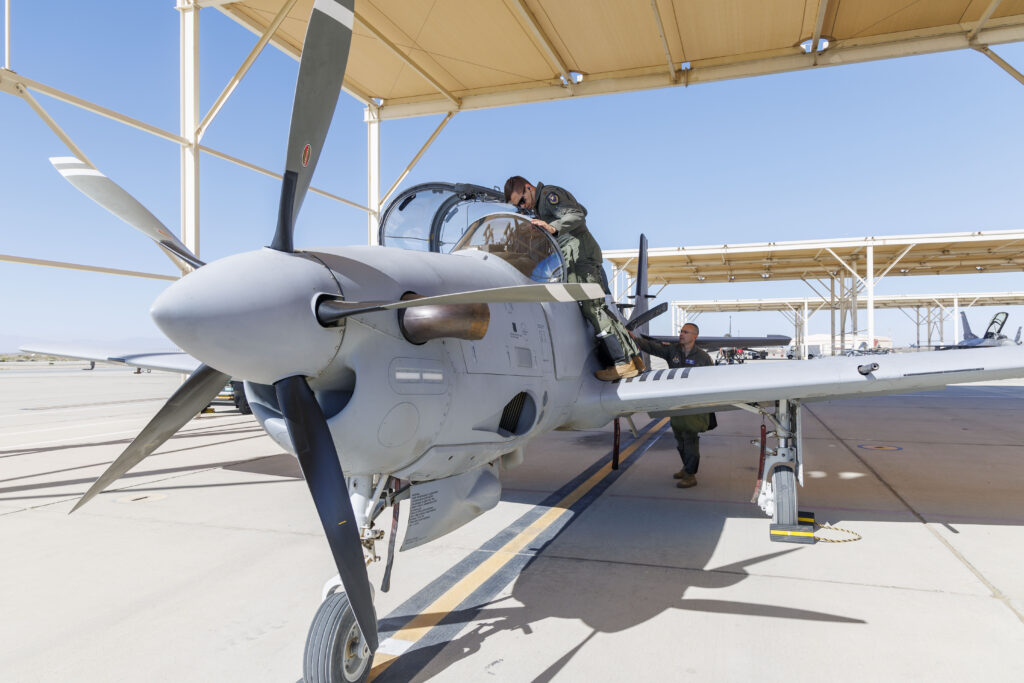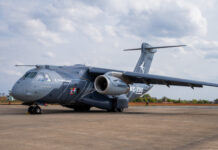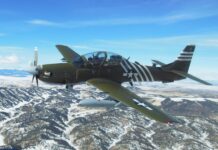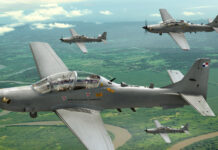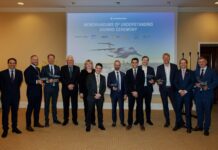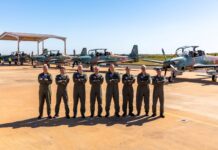The US Air Force Test Pilot School has commenced training operations with three A-29C Super Tucano turboprops at Edwards Air Force base (AFB) in California, the air force announced on 10 July 2025.
The three aircraft, provided by Sierra Nevada Corporation (SNC) in conjunction with Super Tucano manufacturer Embraer, were initially acquired by Air Force Special Operations Command (AFSOC) for its Light Attack/Armed Reconnaissance (LAAR) programme, although this effort was ultimately cancelled in early 2020.
The three aircraft were then temporarily stored at Davis-Monthan AFB in Arizona, but were then returned to flightworthiness and arrived at Edwards AFB on 18 July 2024. Because the A-29C did not have a US Air Force (USAF) programme of record, this required three instructors at the test pilot school having to perform the flight to Edwards with zero formal flight training on the type.
Once safely at Edwards AFB, the A-29Cs spent the next six months going through extensive maintenance in collaboration with SNC. This allowed instructors to thoroughly study the aircraft, refine procedures and develop a comprehensive training plan.
“The modern avionics and robust airframe design allow the A-29C to be one of few aircraft within the US Air Force Test Pilot School curriculum to be utilized for multiple events and lessons, or what the school defines as a ‘jack-of-all-trades’,” the USAf stated in a press release.
The aircraft will first primarily be used by the test pilot school for stall and spin training. Evaluating and testing aircraft stall and spin characteristics is a crucial skill set for every test pilot school graduate. While the USAF currently has a glider spin sortie and an F-16 departure flight, the former offers limited repetitions and flight dynamics, while the latter is only applicable to graduates who go on to test fighter aircraft. The new A-29Cs will be able to execute many types of spins with an endurance of over one-and-a-half hours, maximising learning for all students.
Once these flights are established, the school’s curriculum will delve into the A-29C’s mission systems. The aircraft can carry an MX-15 sensor ball, use the Link 16 datalink, communicate through a VORTEX link, and employ laser-guided bombs and rockets. These systems will equip students with the knowledge and skills necessary to test and evaluate similar mission systems on current and emerging platforms. This will also help reduce flying hour and maintenance strain on the F-16 fleet at Edwards AFB, allowing the Sensors Demo, Weapons Demo and Mission Systems Practical Exam to be uniquely performed on the A-29C.
As with any test asset, the new A-29C’s will require special instrumentation to enable advanced data collection and control room operations, which is currently ongoing, the USAF explained. The school is also exploring the potential integration of the Agile Pod, which would further enhance the mission systems capabilities. With five weapon stations per aircraft, the A-29C also allows future flexibility for research and development efforts through the Air Force Test Pilot School’s Research Division. The backseat in the A-29 also houses a dedicated controller station that could be used in future for combat systems officers and remotely piloted aircraft students as the concept of manned/unmanned teaming further grows across USAF operations.
“The more we learn about the A-29C Super Tucano, the more robust our syllabus becomes,” Major Mateusz Borek, flight sciences assistant department chair and A-29 chief pilot for the test pilot school, was quoted as saying. “This is an exciting time to be an instructor and student at the school,” Maj Borek added.
The A-29C will continue to increase operations throughout the summer, with Class 25A becoming the first group of students to fly the aircraft.
